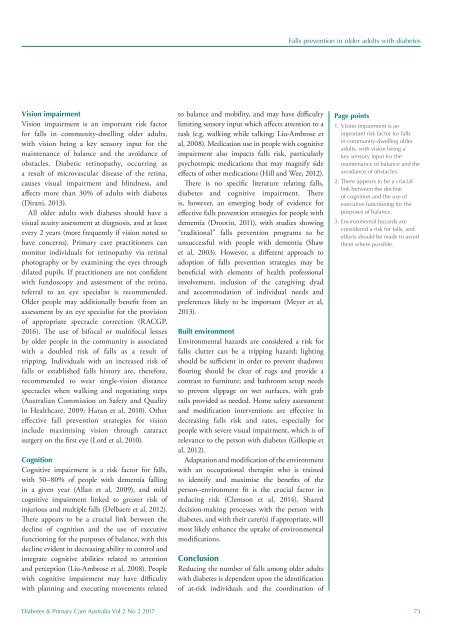DPCA2-2_issue_v3
You also want an ePaper? Increase the reach of your titles
YUMPU automatically turns print PDFs into web optimized ePapers that Google loves.
Falls prevention in older adults with diabetes<br />
Vision impairment<br />
Vision impairment is an important risk factor<br />
for falls in community-dwelling older adults,<br />
with vision being a key sensory input for the<br />
maintenance of balance and the avoidance of<br />
obstacles. Diabetic retinopathy, occurring as<br />
a result of microvascular disease of the retina,<br />
causes visual impairment and blindness, and<br />
affects more than 30% of adults with diabetes<br />
(Dirani, 2013).<br />
All older adults with diabetes should have a<br />
visual acuity assessment at diagnosis, and at least<br />
every 2 years (more frequently if vision noted to<br />
have concerns). Primary care practitioners can<br />
monitor individuals for retinopathy via retinal<br />
photography or by examining the eyes through<br />
dilated pupils. If practitioners are not confident<br />
with fundoscopy and assessment of the retina,<br />
referral to an eye specialist is recommended.<br />
Older people may additionally benefit from an<br />
assessment by an eye specialist for the provision<br />
of appropriate spectacle correction (RACGP,<br />
2016). The use of bifocal or multifocal lenses<br />
by older people in the community is associated<br />
with a doubled risk of falls as a result of<br />
tripping. Individuals with an increased risk of<br />
falls or established falls history are, therefore,<br />
recommended to wear single-vision distance<br />
spectacles when walking and negotiating steps<br />
(Australian Commission on Safety and Quality<br />
in Healthcare, 2009; Haran et al, 2010). Other<br />
effective fall prevention strategies for vision<br />
include maximising vision through cataract<br />
surgery on the first eye (Lord et al, 2010).<br />
Cognition<br />
Cognitive impairment is a risk factor for falls,<br />
with 50–80% of people with dementia falling<br />
in a given year (Allan et al, 2009), and mild<br />
cognitive impairment linked to greater risk of<br />
injurious and multiple falls (Delbaere et al, 2012).<br />
There appears to be a crucial link between the<br />
decline of cognition and the use of executive<br />
functioning for the purposes of balance, with this<br />
decline evident in decreasing ability to control and<br />
integrate cognitive abilities related to attention<br />
and perception (Liu-Ambrose et al, 2008). People<br />
with cognitive impairment may have difficulty<br />
with planning and executing movements related<br />
to balance and mobility, and may have difficulty<br />
limiting sensory input which affects attention to a<br />
task (e.g. walking while talking; Liu-Ambrose et<br />
al, 2008). Medication use in people with cognitive<br />
impairment also impacts falls risk, particularly<br />
psychotropic medications that may magnify side<br />
effects of other medications (Hill and Wee, 2012).<br />
There is no specific literature relating falls,<br />
diabetes and cognitive impairment. There<br />
is, however, an emerging body of evidence for<br />
effective falls prevention strategies for people with<br />
dementia (Drootin, 2011), with studies showing<br />
“traditional” falls prevention programs to be<br />
unsuccessful with people with dementia (Shaw<br />
et al, 2003). However, a different approach to<br />
adoption of falls prevention strategies may be<br />
beneficial with elements of health professional<br />
involvement, inclusion of the caregiving dyad<br />
and accommodation of individual needs and<br />
preferences likely to be important (Meyer et al,<br />
2013).<br />
Built environment<br />
Environmental hazards are considered a risk for<br />
falls: clutter can be a tripping hazard; lighting<br />
should be sufficient in order to prevent shadows;<br />
flooring should be clear of rugs and provide a<br />
contrast to furniture; and bathroom setup needs<br />
to prevent slippage on wet surfaces, with grab<br />
rails provided as needed. Home safety assessment<br />
and modification interventions are effective in<br />
decreasing falls risk and rates, especially for<br />
people with severe visual impairment, which is of<br />
relevance to the person with diabetes (Gillespie et<br />
al, 2012).<br />
Adaptation and modification of the environment<br />
with an occupational therapist who is trained<br />
to identify and maximise the benefits of the<br />
person–environment fit is the crucial factor in<br />
reducing risk (Clemson et al, 2014). Shared<br />
decision-making processes with the person with<br />
diabetes, and with their carer(s) if appropriate, will<br />
most likely enhance the uptake of environmental<br />
modifications.<br />
Conclusion<br />
Reducing the number of falls among older adults<br />
with diabetes is dependent upon the identification<br />
of at-risk individuals and the coordination of<br />
Page points<br />
1. Vision impairment is an<br />
important risk factor for falls<br />
in community-dwelling older<br />
adults, with vision being a<br />
key sensory input for the<br />
maintenance of balance and the<br />
avoidance of obstacles.<br />
2. There appears to be a crucial<br />
link between the decline<br />
of cognition and the use of<br />
executive functioning for the<br />
purposes of balance.<br />
3. Environmental hazards are<br />
considered a risk for falls, and<br />
efforts should be made to avoid<br />
them where possible.<br />
Diabetes & Primary Care Australia Vol 2 No 2 2017 73
















